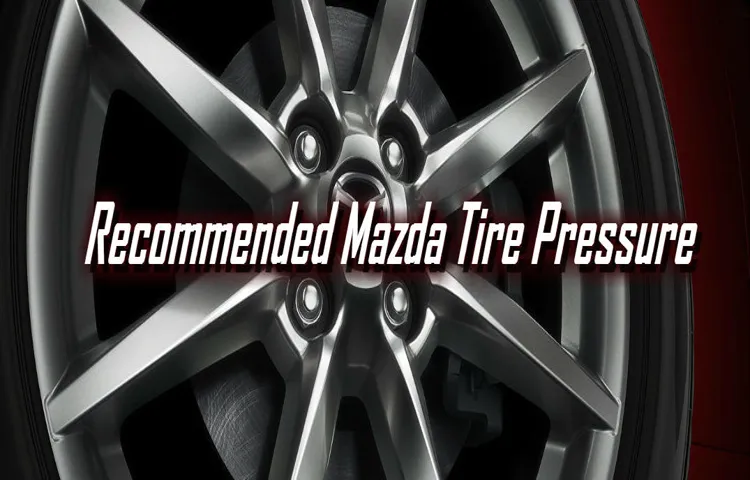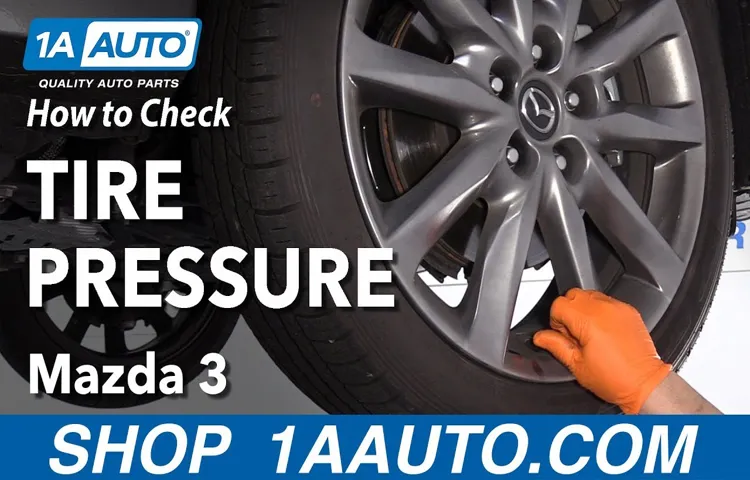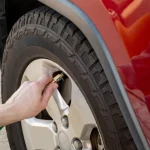Have you ever been driving down the road and noticed your tire pressure light come on? It’s a common occurrence, yet many drivers tend to ignore it or assume it’s not a pressing issue. However, maintaining correct tire pressure is crucial for a number of reasons. Not only does it improve your vehicle’s fuel efficiency and handling, but it also ensures your safety on the road.
In this blog, we’ll explore the importance of correct tire pressure and provide some tips on how to maintain it. So buckle up and let’s dive in!
Table of Contents
Mazda 3 Tire Specifications
As a Mazda 3 owner, it’s important to know the correct tire pressure for your car. The recommended tire pressure varies depending on whether you have a sedan or hatchback, and whether you have standard or sport suspension. For the sedan with standard suspension, the correct tire pressure is 36 psi both front and rear.
For the sedan with sport suspension, it’s 33 psi in front and 35 psi in the back. The recommended tire pressure for the hatchback with standard suspension is 36 psi in front and rear, while the hatchback with sport suspension should have 33 psi in front and 35 psi in the back. It’s important to regularly check your tire pressure and adjust it as necessary for optimal performance and safety.
Failure to maintain the correct tire pressure could lead to poor fuel efficiency, uneven tire wear, and even accidents on the road.
Steps to Check Your Tire Pressure
Maintaining proper tire pressure is essential for safe driving and prolonging tire life. To check your tire pressure on a Mazda 3, you’ll need to first refer to its tire specifications. The recommended tire pressure can differ depending on the tire size and model year.
For instance, the 2021 Mazda 3 Sedan with P215/45R18 89W requires a front tire pressure of 36 psi and a rear tire pressure of 33 psi. Once you know your tire’s recommended pressure, you can check the pressure with a tire pressure gauge. Simply remove the valve cap, firmly press the gauge onto the valve stem, and read the pressure measurement.
If the pressure is low, use an air compressor to fill the tire to the recommended pressure. But be careful not to over-inflate, which can lead to uneven tire wear and reduced handling performance. Checking your tire pressure regularly and maintaining it at the recommended level will help ensure a safe and comfortable driving experience.

Factors That Affect Tire Pressure
If you’re a proud owner of a Mazda 3, then it’s important to know the tire specifications in order to maintain the proper tire pressure. The recommended tire pressure for Mazda 3 varies depending on the trim level and the type of tires installed. For the standard 16-inch tires on the Mazda 3 Sport and Touring, the recommended tire pressure is 36 psi for both front and rear wheels.
If you have the grand touring trim, then the recommended tire pressure is 35 psi for both front and rear wheels. However, if you have the optional 18-inch tires, then the recommended tire pressure for the front wheels is 36 psi and 35 psi for the rear wheels. It’s important to note that higher tire pressures aren’t always better as they can lead to an uncomfortable ride and wear out the center of the tire more quickly.
On the other hand, lower tire pressure can decrease fuel efficiency and cause the tire to wear out on the edges. Keeping the recommended tire pressure in check ensures a safe and smooth driving experience.
Recommended Tire Pressure for Mazda 3
If you’re wondering what the correct tire pressure is for your Mazda 3, you’ve come to the right place. The recommended tire pressure is typically listed in your owner’s manual, but it can also be found on a placard located on the driver’s side door jamb or inside the fuel door. For a Mazda 3, the recommended tire pressure is usually between 32 and 36 psi (pounds per square inch), depending on the model and tire size.
It’s important to make sure you check your tire pressure regularly, as driving with incorrect tire pressure can affect your vehicle’s handling, fuel economy, and overall safety. Additionally, extreme weather conditions can cause the pressure to fluctuate, so it’s a good idea to check it more frequently during temperature changes. Maintaining proper tire pressure can help ensure a smoother, safer ride, and can even extend the life of your tires.
How to Inflate or Deflate Your Tires
As a Mazda 3 owner, it’s important to maintain the proper tire pressure for optimal performance and safety on the road. The recommended tire pressure for the Mazda 3 can vary depending on the specific model and year, but it’s typically around 32 PSI for all four tires. To ensure accuracy, it’s recommended to check the pressure when the tires are cold, before driving or when parked for at least three hours.
Overinflated tires can lead to a harsh ride and potential damage or wear on the tire, while underinflated tires can cause poor fuel economy and handling. To properly inflate or deflate your tires, you’ll need a tire pressure gauge and an air compressor or pump. Remember to always use the recommended pressure and check your tire pressure regularly to maintain optimal performance and safety on your Mazda
Checking Your Tire Pressure on a Regular Basis
When it comes to maintaining the performance and safety of your Mazda 3, checking the tire pressure is a simple but essential task that cannot be overlooked. The recommended tire pressure for the Mazda 3 varies depending on the model and year, so it’s important to refer to the owner’s manual or the sticker located on the driver’s side door frame for the correct pressure. In general, most Mazda 3 models require a tire pressure of around 32-36 psi for optimal handling, fuel efficiency, and tire life.
It’s recommended to check the tire pressure at least once a month, as changes in temperature and driving habits can affect the pressure. Driving with underinflated or overinflated tires can be dangerous and can lead to poor handling, uneven wear, and even a blowout. By taking a few minutes to check your tire pressure regularly, you can ensure a smooth and safe driving experience in your Mazda
Consequences of Incorrect Tire Pressure
As a Mazda 3 owner, you must be aware of the importance of maintaining appropriate tire pressure to ensure a smooth ride and optimal driving capability. Incorrect tire pressure can lead to several consequences such as reduced fuel efficiency, uneven tire wear, compromised handling and steering, and increased risk of blowouts. Hence, it is vital to check your tire pressure at least once a month and particularly before long trips.
The recommended tire pressure for Mazda 3 varies depending on the model and year. For instance, the 2019 Mazda 3 Sedan and Hatchback require a tire pressure of 36 psi, while the 2021 Mazda 3 requires 35 psi for the front and back tires. You can easily find this information in your owner’s manual or on the driver’s side door jam.
Ensuring the correct tire pressure will not only prevent undesirable consequences but also extend the life of your tires, ensure a comfortable and stable ride, and enhance your safety on the road. So, make it a habit to check your tire pressure regularly and stay safe on the road!
Conclusion
In conclusion, the correct tire pressure for a Mazda 3 can be found in the owner’s manual or on the tire placard located on the driver’s side door jamb. Remember, maintaining the correct tire pressure not only ensures a smooth and safe ride but also saves you from having to explain to your friends why your car looks like it’s been on a rough safari expedition.”
Tips for Maintaining Correct Tire Pressure
Maintaining the correct tire pressure is essential for the safety and performance of your Mazda The recommended tire pressure for a Mazda 3 is usually between 32-36 PSI. However, it is essential to check your owner’s manual or the sticker on the driver’s side door jamb for precise pressure specifications.
Keeping your Mazda 3 tires inflated to the correct level can enhance your car’s fuel efficiency, improve handling, and prevent premature tire wear, improving the longevity of your tires. Moreover, the correct tire pressure ensures maximum tire grip, allowing for safe driving and braking in all weather conditions. Checking your tire pressure regularly with a tire pressure gauge and inflating your tires to the recommended level is the best way to maintain your Mazda 3’s tires.
Additionally, it is essential to check your tire pressure before extended road trips or when carrying heavy loads. Remember, proper tire pressure is crucial for safe and enjoyable driving.
Final Thoughts
When it comes to maintaining your Mazda 3, one important factor that should not be overlooked is tire pressure. The recommended tire pressure for a Mazda 3 varies depending on the model year and the type of tires you have, but generally falls between 32 and 36 psi. Proper tire inflation not only improves fuel economy, but also ensures optimal traction, handling, and durability.
Low tire pressure can result in decreased fuel efficiency, reduced tire life, increased stopping distance, and even blowouts. On the other hand, overinflation can lead to uneven tire wear, decreased ride comfort, and reduced handling. To determine the recommended tire pressure for your specific Mazda 3 model and tires, consult your owner’s manual or the label located inside the driver’s door jamb.
Always check your tire pressure regularly, especially after changes in temperature or driving conditions, and adjust as needed. By maintaining the recommended tire pressure, you can keep your Mazda 3 running smoothly and safely on the road.
FAQs
Why is it important to maintain the correct tire pressure for a Mazda 3?
Maintaining the correct tire pressure ensures optimum handling, improves fuel efficiency, and extends tire life.
What is the recommended tire pressure for a Mazda 3?
The recommended tire pressure for a Mazda 3 is listed in the owner’s manual and typically ranges from 32-36 PSI.
How often should I check and adjust my Mazda 3’s tire pressure?
It is recommended to check and adjust tire pressure at least once a month, and before long trips or when the weather changes.
Can I use the tire pressure listed on the sidewall of my Mazda 3’s tires?
No, the tire pressure listed on the tire’s sidewall is the maximum pressure the tire can handle and may not be the correct pressure for your specific vehicle.
What is the impact of driving with underinflated tires on a Mazda 3?
Driving with underinflated tires can lead to decreased fuel efficiency, reduced handling and braking performance, and premature tire wear.
How do I check and adjust my Mazda 3’s tire pressure?
Use a tire pressure gauge to check the pressure of each tire and add or release air as needed until the pressure matches the recommended level in the owner’s manual.
Can I trust the tire pressure monitoring system on my Mazda 3?
While the tire pressure monitoring system can be a helpful tool, it is still important to manually check tire pressure as the system may not always detect a gradual loss of pressure.



